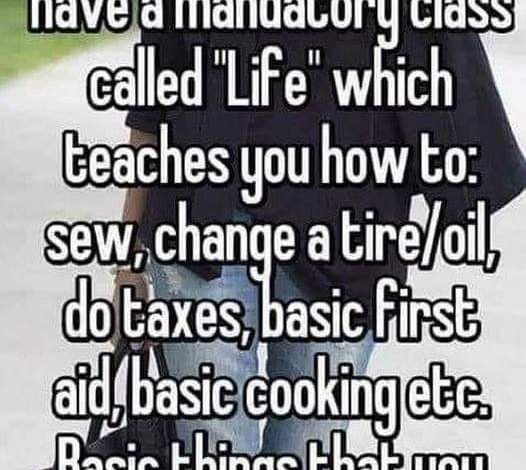
ADVERTISEMENT
Why Every School Should Teach a “Life Skills” Class
Introduction
In today’s fast-paced and ever-changing world, education plays a crucial role in preparing individuals for the challenges of adulthood. While schools emphasize academic subjects like math, science, and literature, there is often a noticeable gap when it comes to practical skills that students will need in their daily lives. Imagine a mandatory high school course titled “Life Skills,” designed to teach basic, real-world knowledge such as sewing, changing a tire, doing taxes, performing first aid, and cooking simple meals. Such a class could bridge the gap between theoretical education and the practical realities of adulthood, equipping students with tools for independence and success.
Body
A life skills class would address a fundamental issue: the lack of practical education in many school curriculums. For instance, most young adults graduate without ever learning how to prepare a budget, file their taxes, or cook a nutritious meal. These skills are not luxuries—they are necessities for functioning in the real world. By including them in the curriculum, schools would ensure that students leave equipped not only to excel in their careers but also to manage their personal lives effectively.
One of the key topics in a life skills class could be basic car maintenance. Knowing how to change a tire or check oil levels could save individuals from costly repairs or dangerous situations. Similarly, sewing is another underrated skill that could teach students how to mend clothes instead of constantly replacing them, promoting sustainability and self-reliance.
Another important component would be financial literacy. Many students enter adulthood with little understanding of how taxes work, how to save for retirement, or even how to open a bank account. These gaps often lead to financial struggles that could have been avoided with early education. A life skills class would teach these basics, setting students up for long-term financial stability.
ADVERTISEMENT
Basic first aid could also be an essential part of the curriculum. Learning how to perform CPR, treat minor injuries, or react in emergencies could literally save lives. Similarly, learning basic cooking skills would promote healthier lifestyles and reduce reliance on fast food or processed meals. These skills are small but impactful steps toward building a healthier society.
Critics may argue that students should learn these skills at home, but the reality is that not all families have the resources or knowledge to teach them. A life skills class would ensure equal access to this knowledge for all students, regardless of their background. Moreover, incorporating practical learning into the school day makes education more engaging and directly applicable to students’ futures.
Conclusion
A “Life Skills” class has the potential to transform education by ensuring students graduate with the knowledge they truly need to succeed in adulthood. From financial literacy and first aid to cooking and car maintenance, these practical skills are as important as any academic subject. By teaching students how to navigate real-life challenges, schools would empower them to become more confident, capable, and self-sufficient individuals.
As society continues to evolve, the need for practical education becomes more evident. Introducing a life skills class into every high school curriculum would not only enrich students’ learning experiences but also prepare them to lead independent and fulfilling lives. After all, education isn’t just about passing tests—it’s about preparing for life.
ADVERTISEMENT




